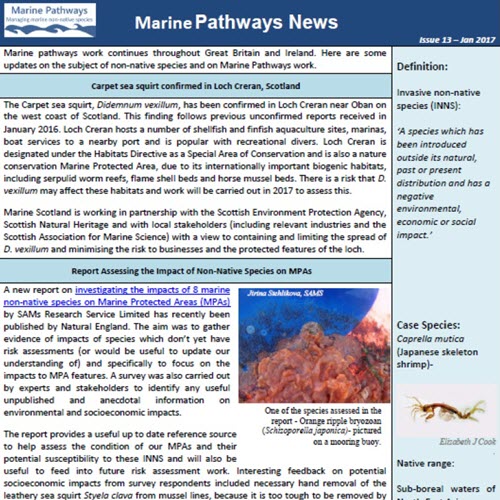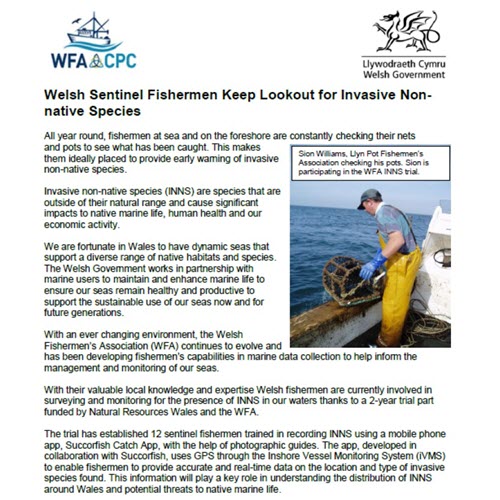Funded by Natural Resources Wales’ (NRW) partnership programme, the Welsh Fishermen’s Association – Cymdeithas Pysgotwyr Cymru (WFA-CPC) and Succorfish have developed and trialled a method for fishermen to monitor and record invasive non-native species (INNS) across Wales.
Operating a variety of static and mobile fishing gear and collecting shellfish along the foreshore, fishermen are well placed to monitor the Welsh coastal waters for INNS as part of their daily fishing activity. Constantly ‘sampling’ their nets and pots and observing their surroundings, fishermen have the potential to be sentinels providing early warning of invasive species. In terms of possible survey effort, fishermen’s observations offer great potential.
In 2016, the WFA-CPC obtained funding from NRW to demonstrate and trial a tool that would enable Welsh fishermen to record INNS over 18 months, from April 2016 to March 2018, and encourage the voluntary adoption of the recording system thereafter.
Summary of the project
- An existing fish recording mobile phone App (CatchApp) developed by Succorfish was adapted to record INNS in Welsh waters.
- Based on their suitability for monitoring by Welsh fishermen, eleven INNS were chosen for the trial: American lobster (Homarus americanus), American oyster drill (Urosalpinx cinereal), Chinese mitten crab (Eriocheir sinensis), American jack knife clam (Ensis directus), Kuruma prawn (Penaeus japonicus), Mantis shrimp (Rissoides desmaresti), Mediterranean mussel (Mytilus galloprovincialus), Pacific oyster (Crasssostrea gigas), Slipper limpet (Crepidula fornicata), Wakame (Undaria pinnatifida) and Wireweed (Sargassum muticum).
- INNS factsheets and identification guides were produced to inform fishermen and help identify the eleven INNS of interest. Pictures of the INNS were placed on the CatchApp and fourteen fishermen and two shellfish farmers were trained on how to identify and record the INNS during 2016.
- From July 2016 to March 2018, fourteen fishermen across Wales spent a total of 956 hours monitoring their catch in pots, lines, otter trawls and dredges and two shellfish farmers, one working a mussel lay and the other an oyster farm spent a total of 156 hours monitoring their sites.
- Two invasive species were recorded by fishermen in areas where they had been recorded in the past; Slipper limpets were recorded in Oxwich and Swansea Bays and Wireweed in the Menai Straits and Inner Caernarfon Bay. Two American lobsters were reported by pot fishermen in new areas; one was caught in an area called ‘The Giblet Shoals’ off Pwllheli in August 2016 (verified by NRW) and the other caught off Conwy in November 2017 (verified by a Mermaid Ltd – a local seafood merchant). An unverified report of an American jack knife clam was recorded in Caernarfon Bay in November 2017 and fishermen reported past sightings, including the capture of Chinese mitten crab off Penmaenmawr in 2014 and an American lobster beneath the Great Orme lighthouse around 2006.
- The project, especially following the reporting of the American lobsters generated a lot of publicity and articles in Fishing News, UK Marine Pathways, the Shellfish Association of Great Britain and Welsh Government (WG) newsletters.

- Following the discovery of the American lobsters, Welsh Government, NRW and WFA-CPC collaborated to produce and disseminate an information leaflet warning seafood merchants throughout Wales and the public of the dangers of releasing American lobsters into the wild and the importance of reporting sightings. WFA-CPC was also contacted by Magnus Johnson, Hull University who, along with colleagues in Norway and Sweden studied the spread of the American lobster in the North Sea.
- Although most fishermen claimed the recording of absence or presence of INNS on the CatchApp was relatively straightforward, some fishermen operating smaller vessels singlehandedly said it was awkward to record data on iphones at sea, opting to input data once on land. Some fishermen stated they needed reminding to send absence records at the end of every month and two fishermen relied on monthly verbal updates.
- Nine fishermen who participated in the trial and an additional five fishermen across Wales agreed to continue monitoring their catch for INNS voluntarily.
- Three fishermen suggested it would be useful to record other species of interest, such as ocean sunfish (Mola mola) and Atlantic bonito (Sarda sarda) that could be important indicators of climate change and species of conservation interest, such as crawfish (Palinurus elephas).
- The trial proved fishermen and shellfish farmers were able, supportive and willing to monitor and record the absence and presence of INNS in their fishing gear and on shellfish lays. The capture of the American lobsters and ensuing publicity alerted fishermen to the risk our native European lobster face from the invasive species (exposure to deadly diseases such as the bacterial disease gaffkaemia and competition for space and food) and generated a lot of interest within the industry.
- Further discussion with WG, NRW and Succorfish was recommended to determine how a formal INNS monitoring programme using fishermen as sentinels in key areas, such as the periphery of known INNS locations to monitor spread, could be established in Wales and how it could be funded.

- A review of whether and if so how the CatchApp could be improved to make it easier to record at sea, allow other species of interest to be easily recorded and explore whether photographs associated with recordings could be submitted was suggested.
- Involving NRW, a protocol to verify INNS reported by fishermen was recommended
- Covering the entire coast, fishermen are well placed to monitor Welsh inshore waters for INNS and combined with fishing operations, their surveillance offers a cost-effective system for Welsh Government to fulfil its duty to monitor INNS under the EU Marine Strategy Framework Directive, Water Framework Directive and EU Invasive Alien Species Regulation (2014), and inform NRW’s Marine Biosecurity Plans.
Download and read the full report
You can hear more about this project from the Project Manager and report author, Mark Gray, who is speaking at the NBN Conference on Thursday 22 November.
